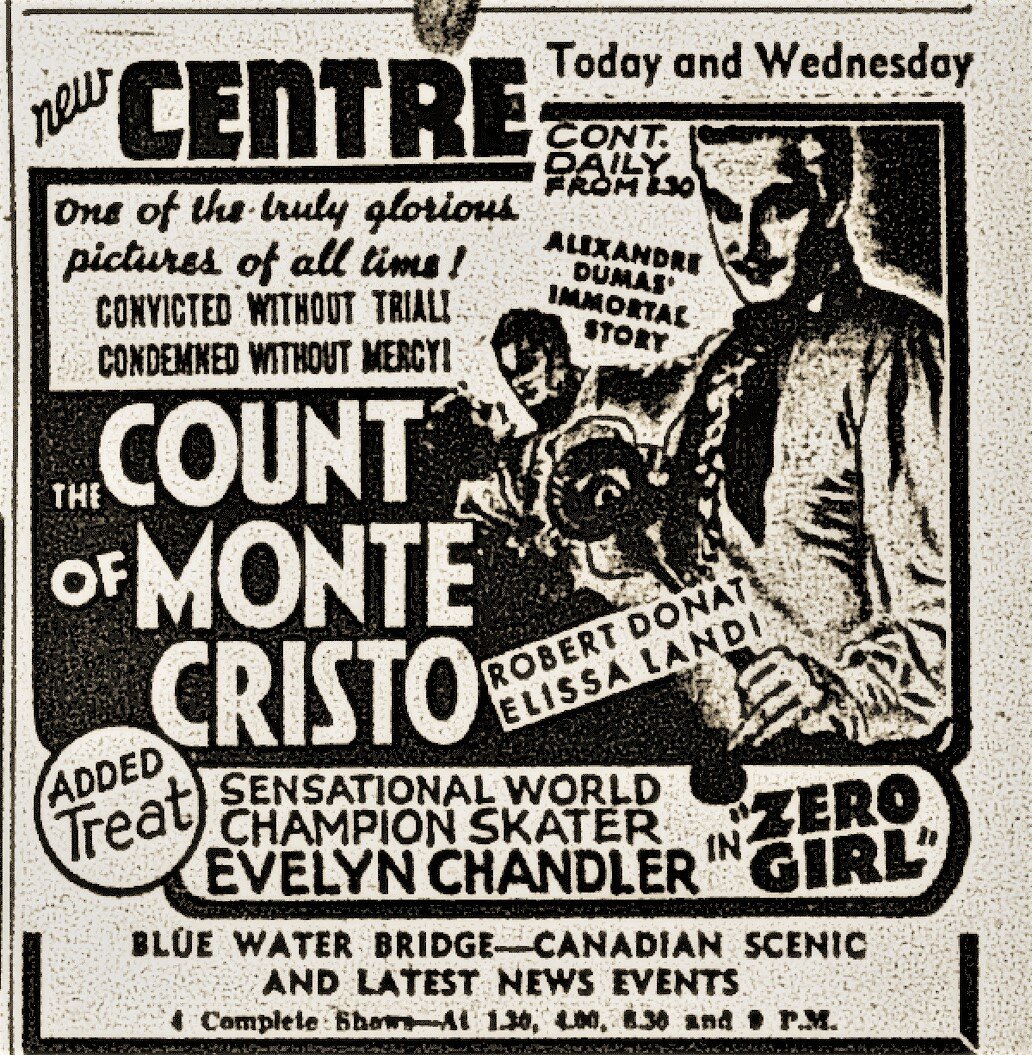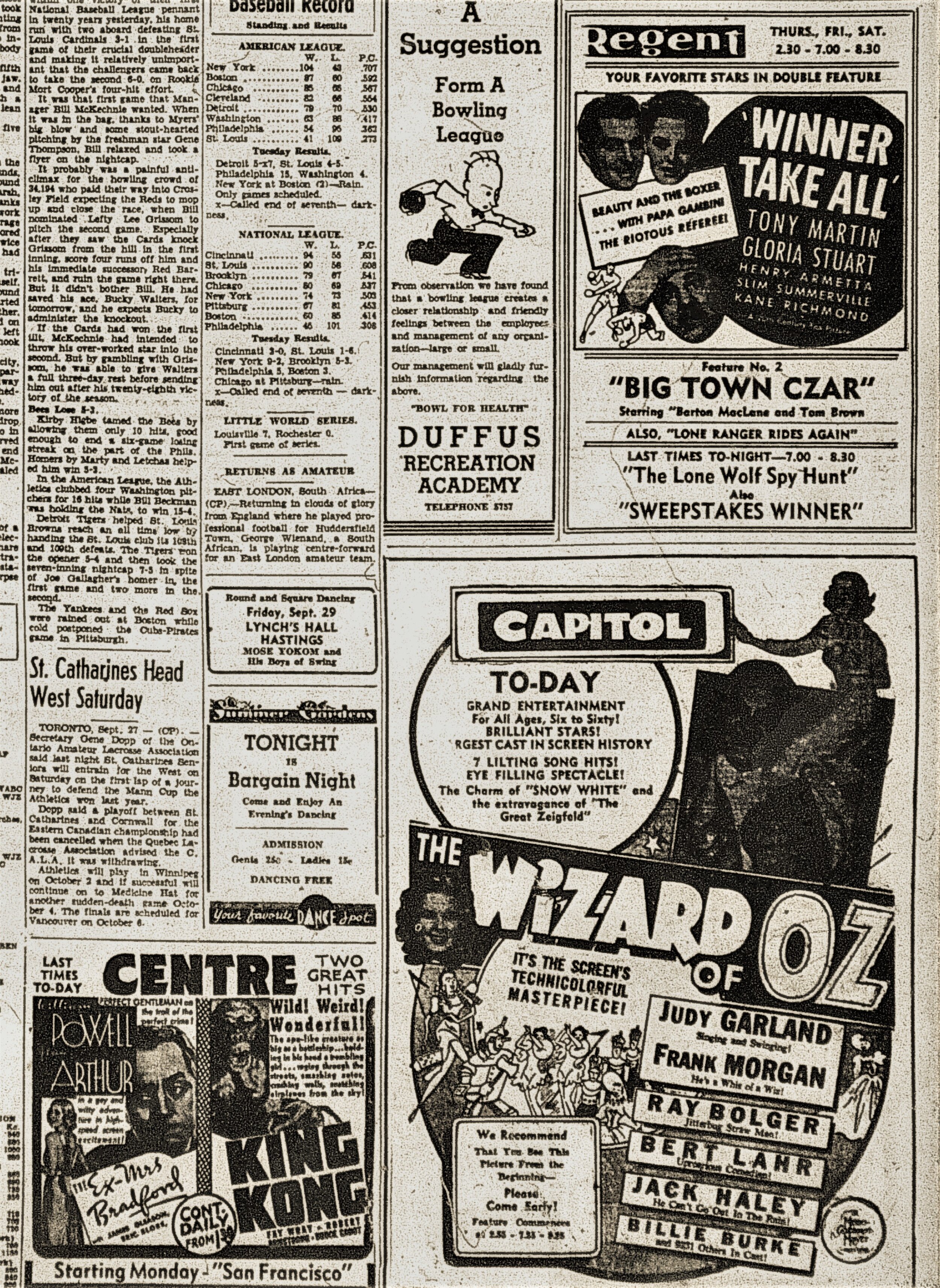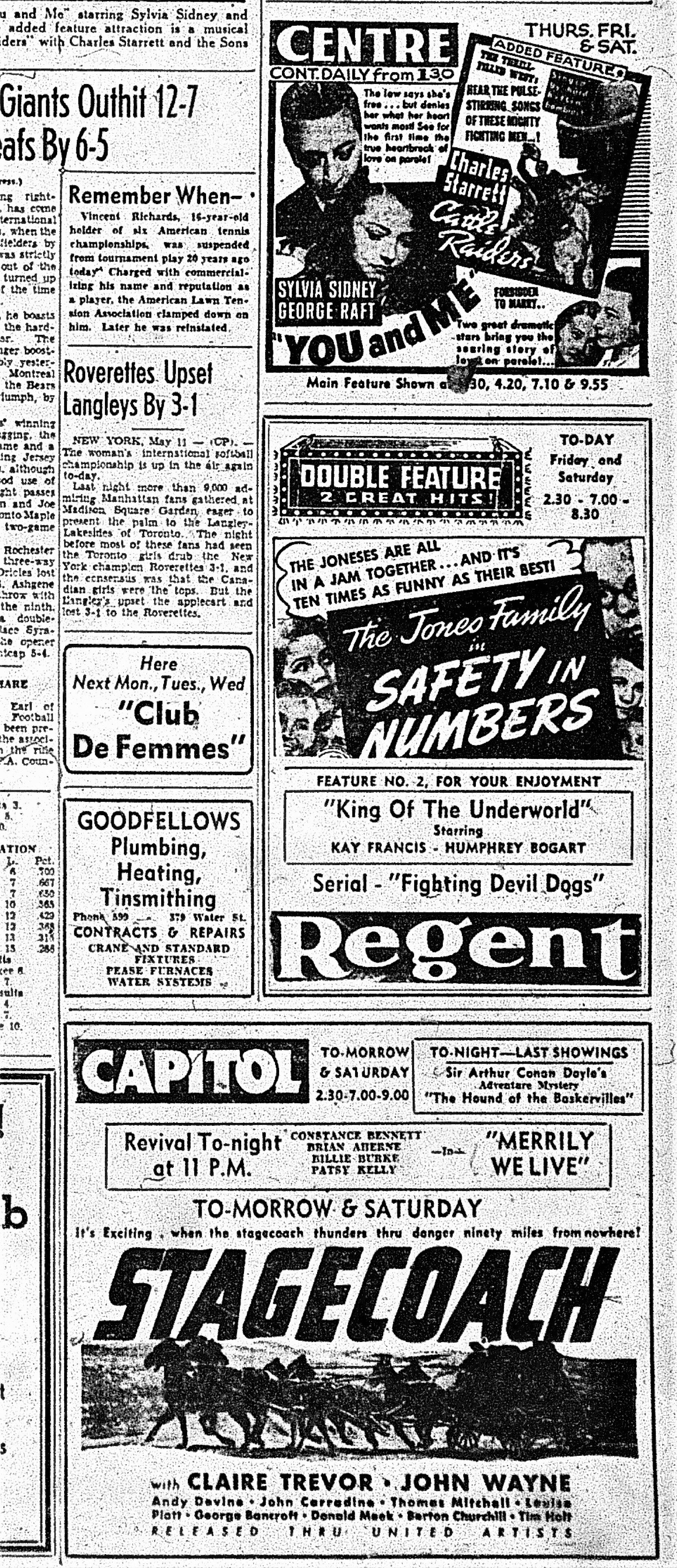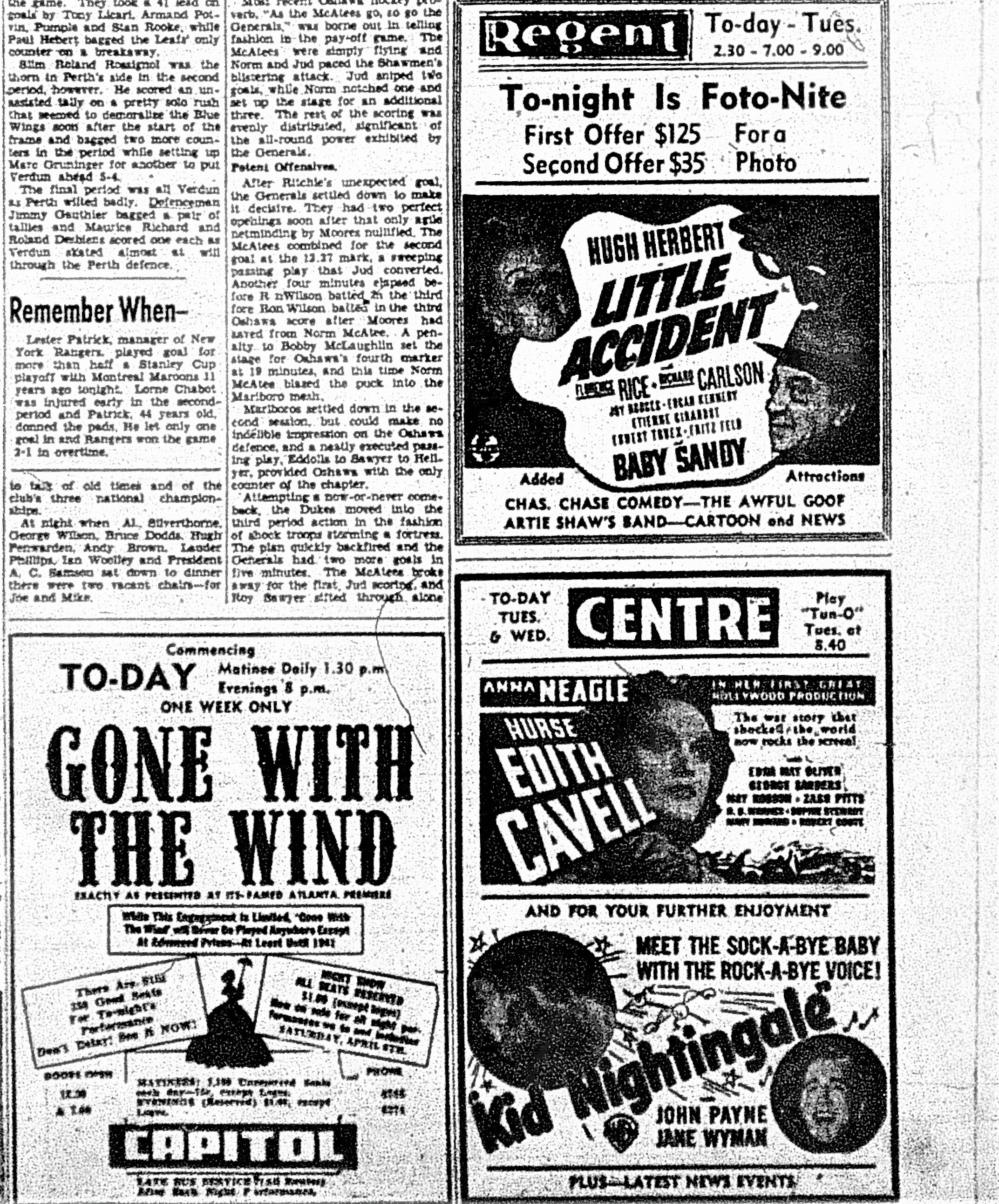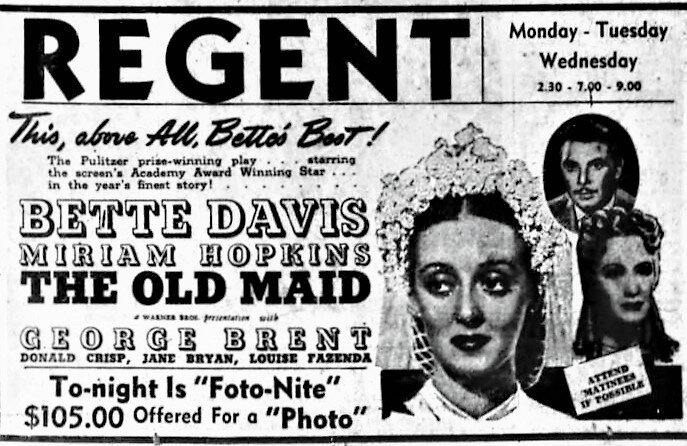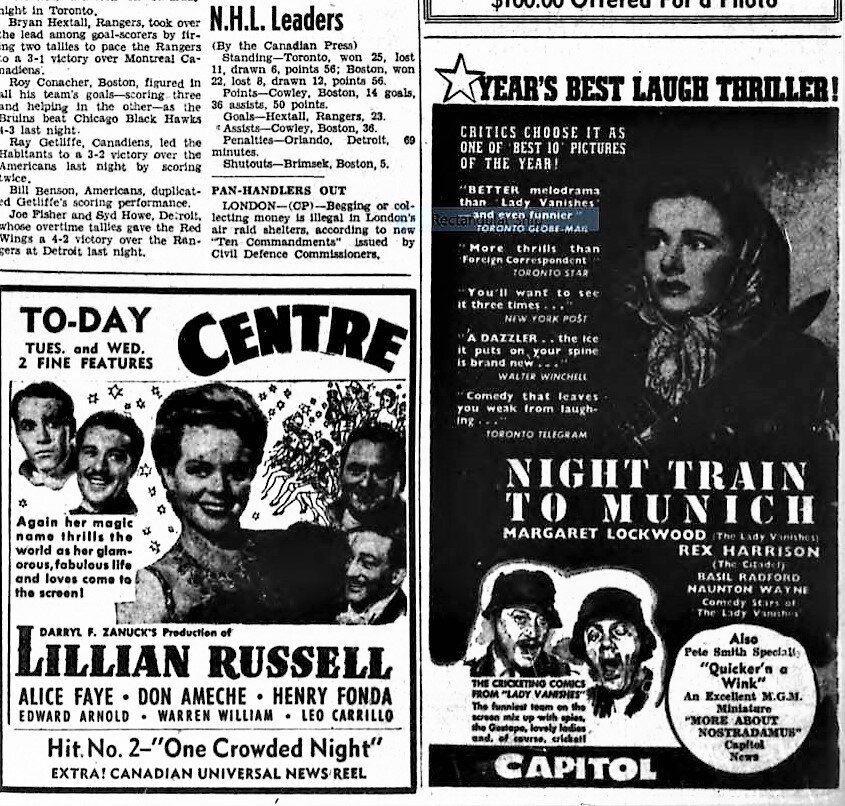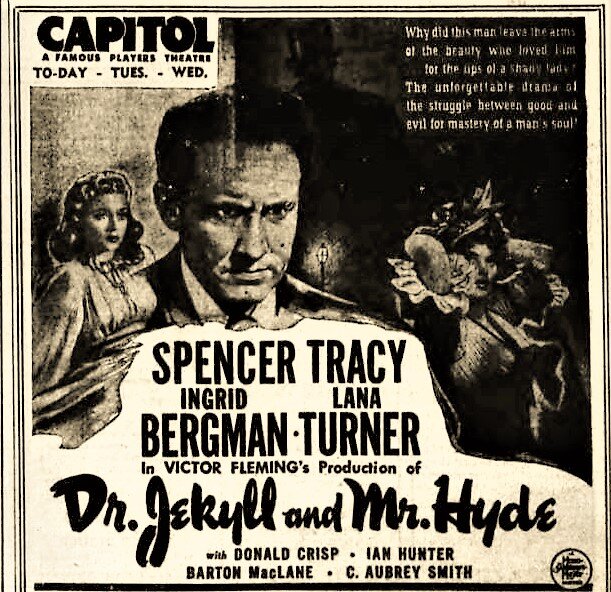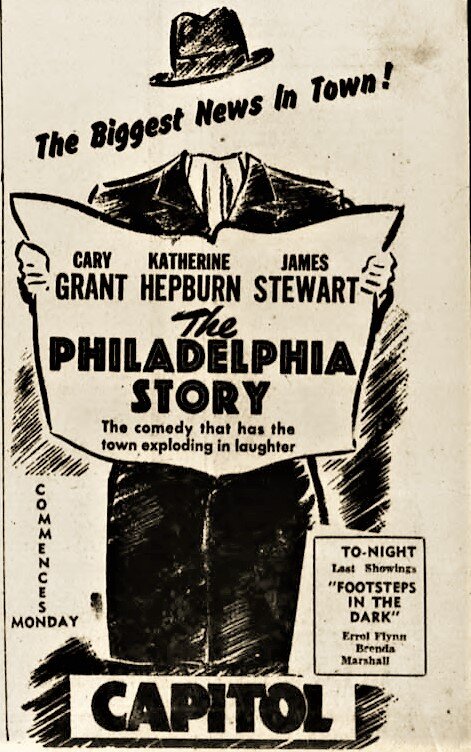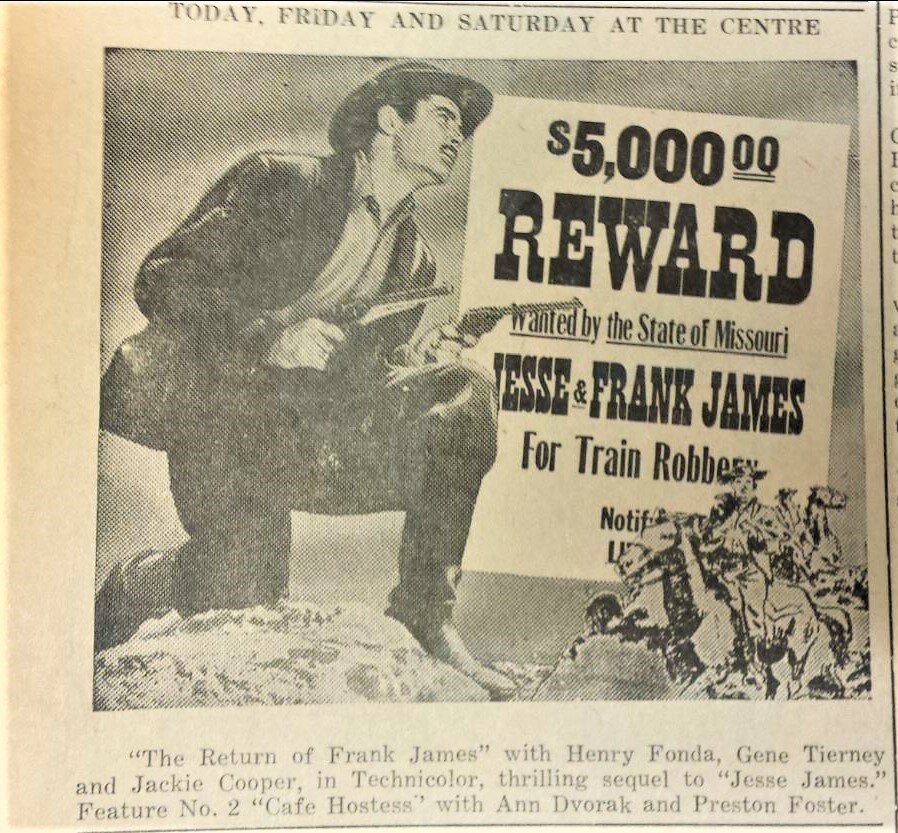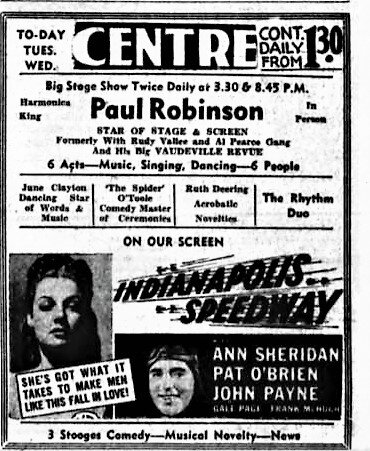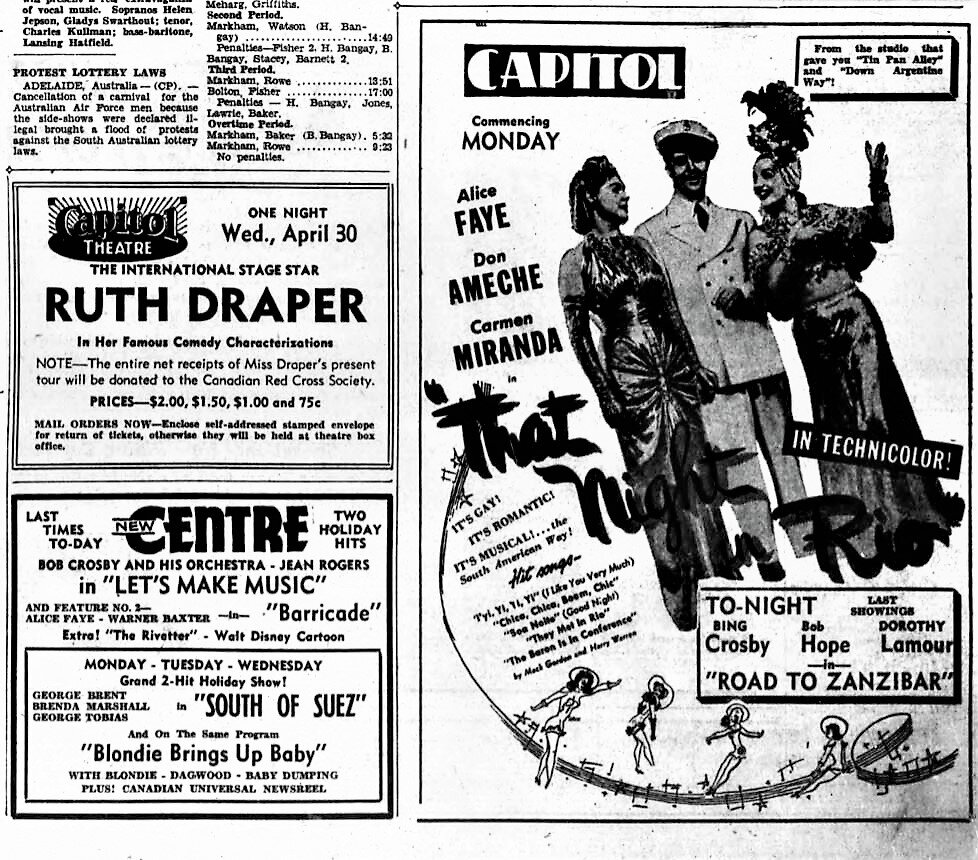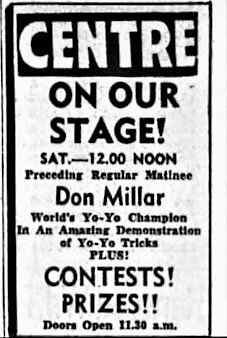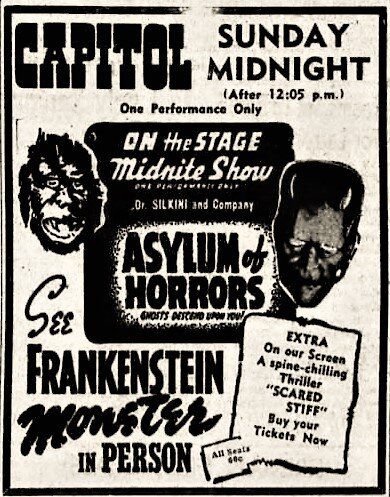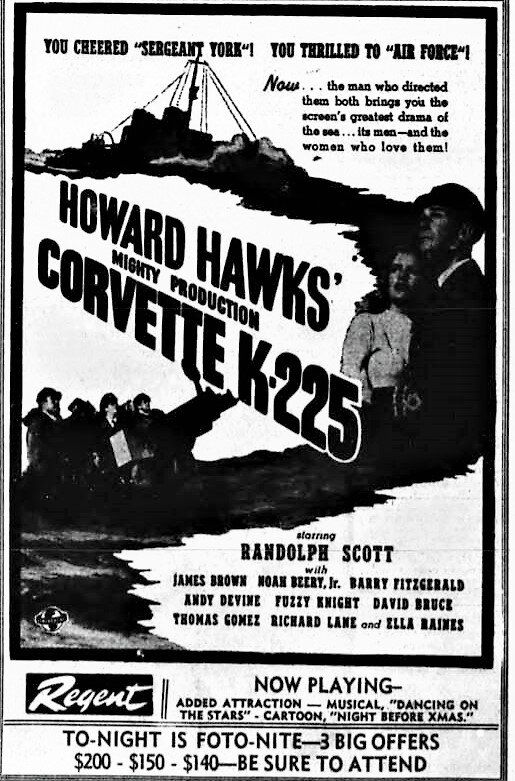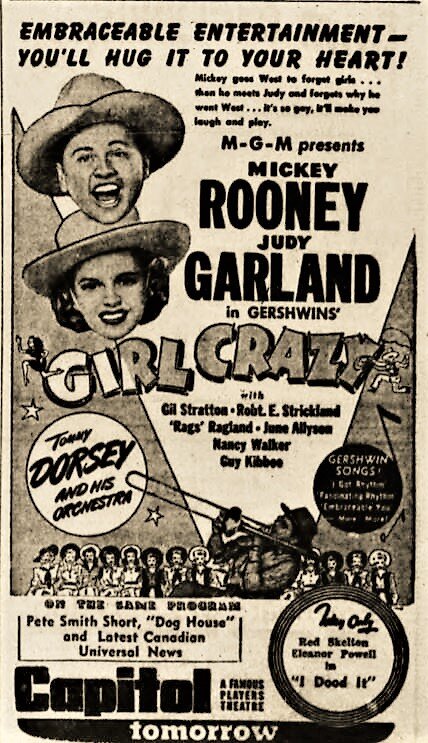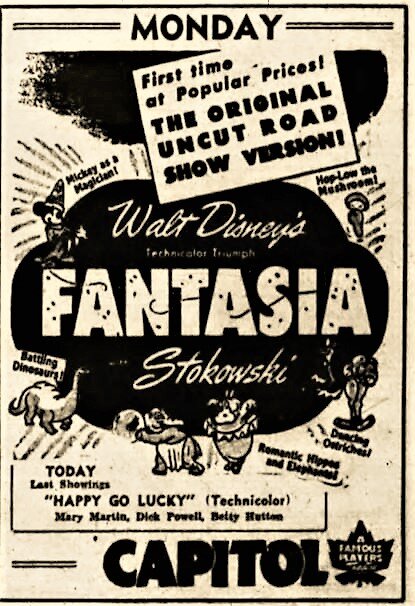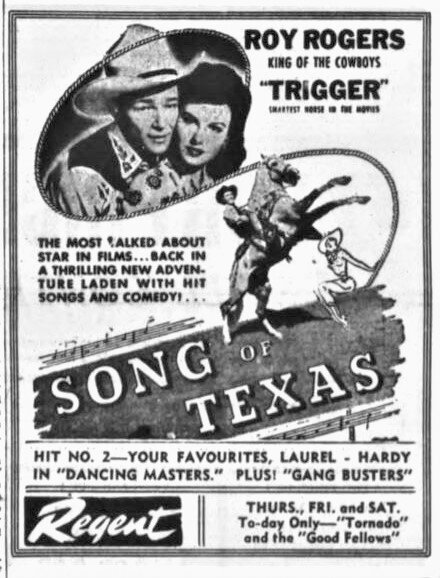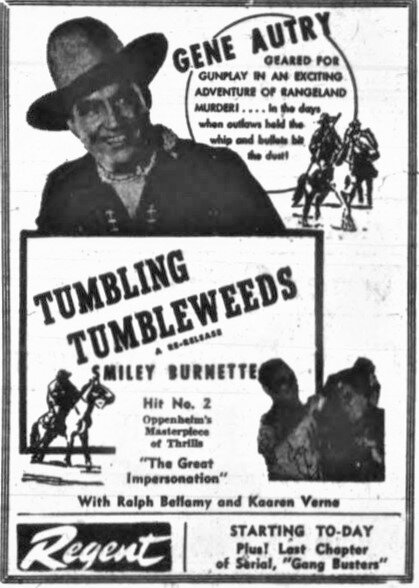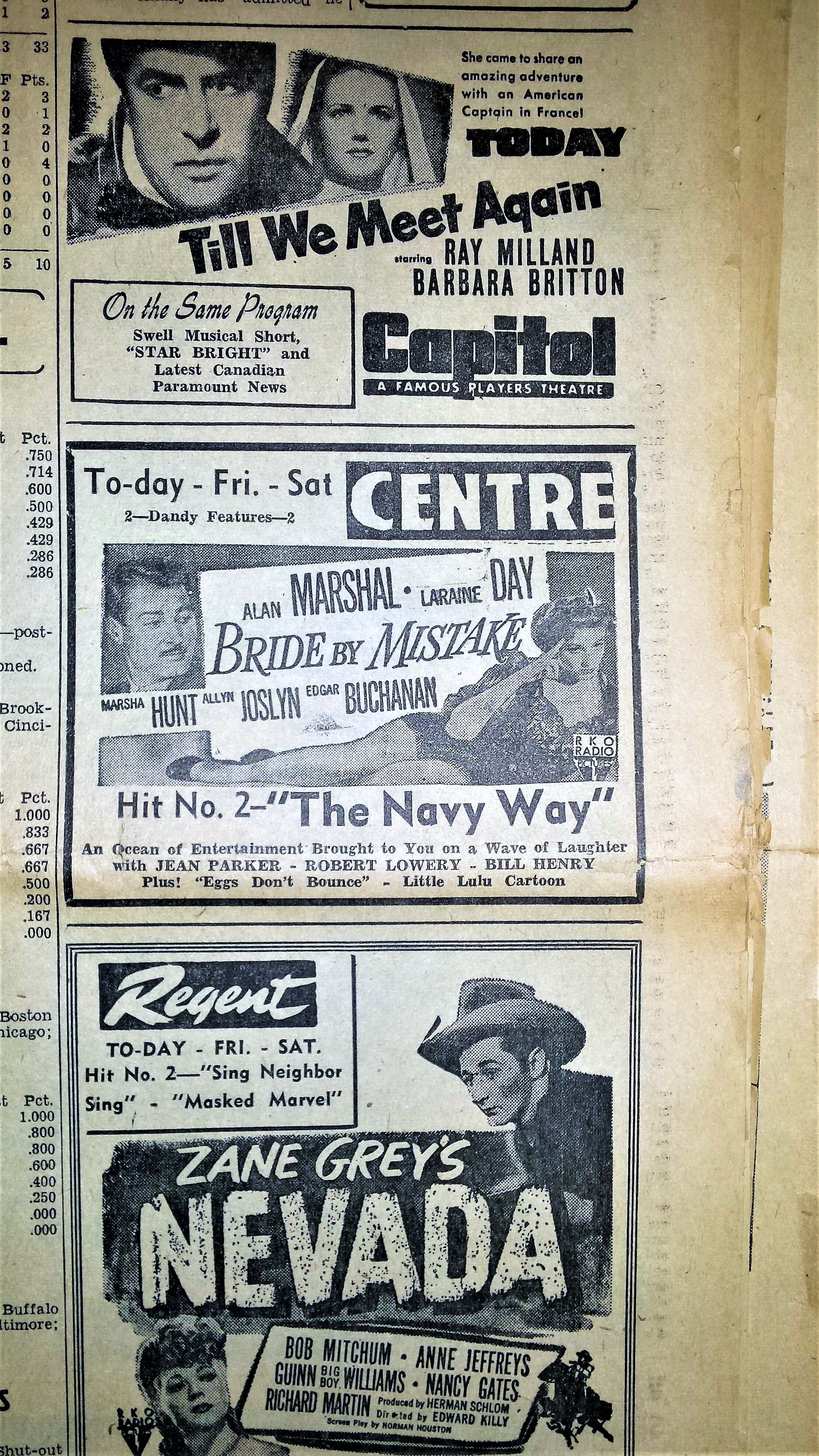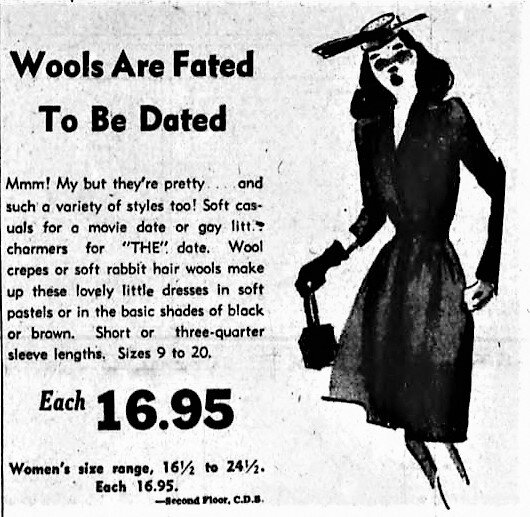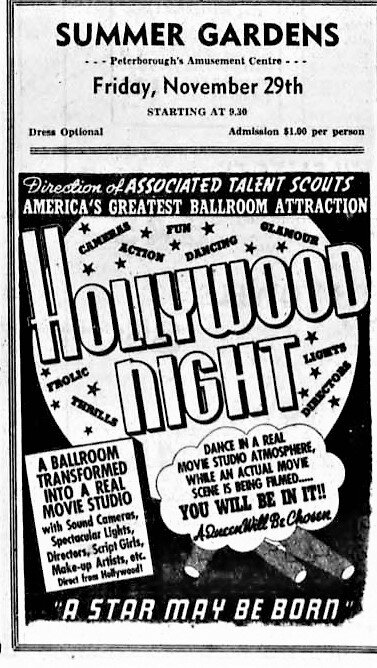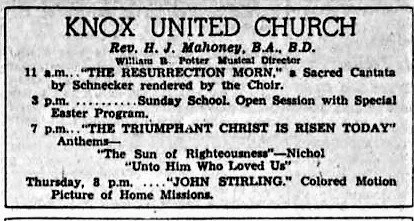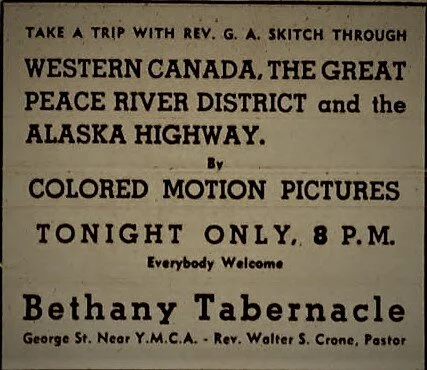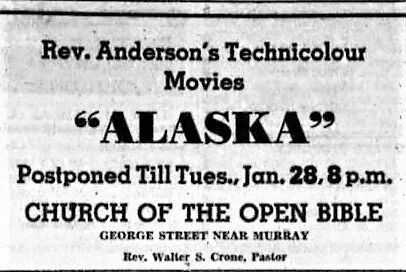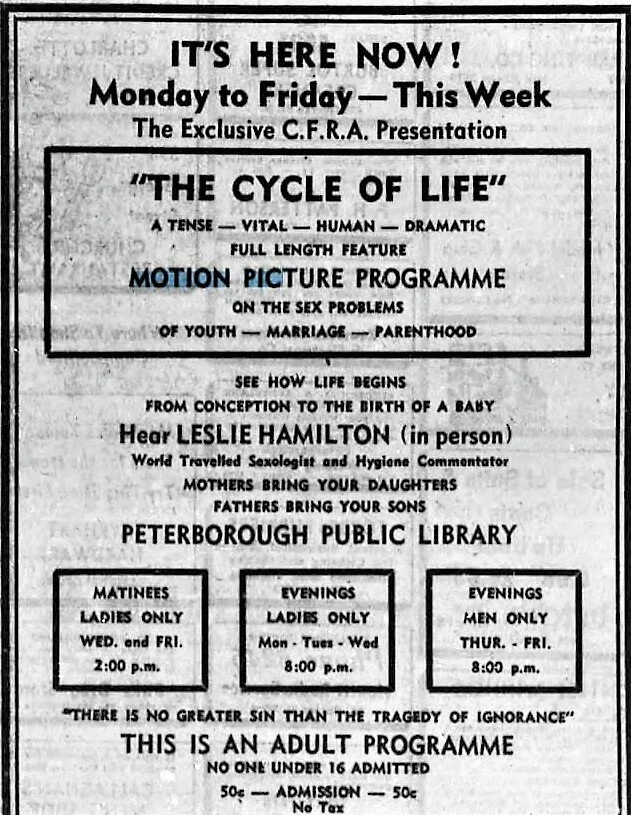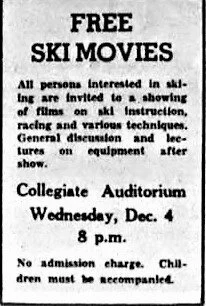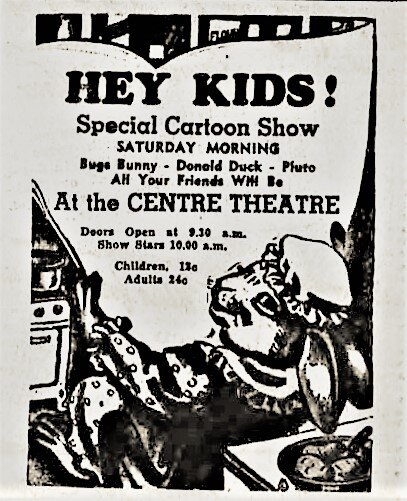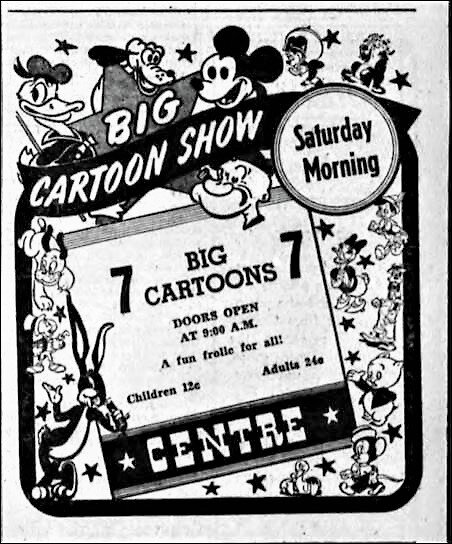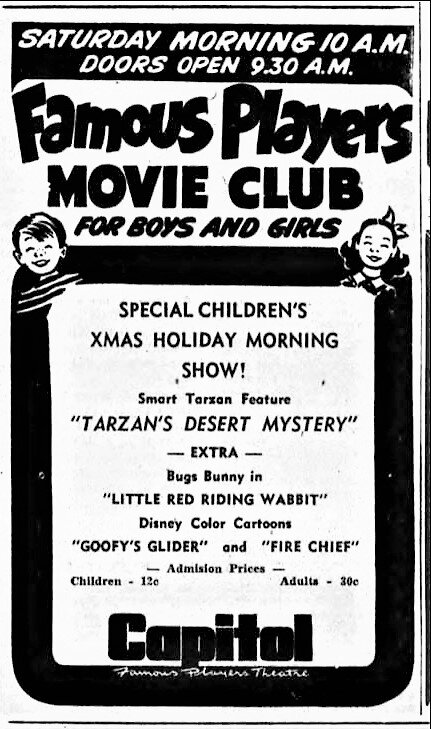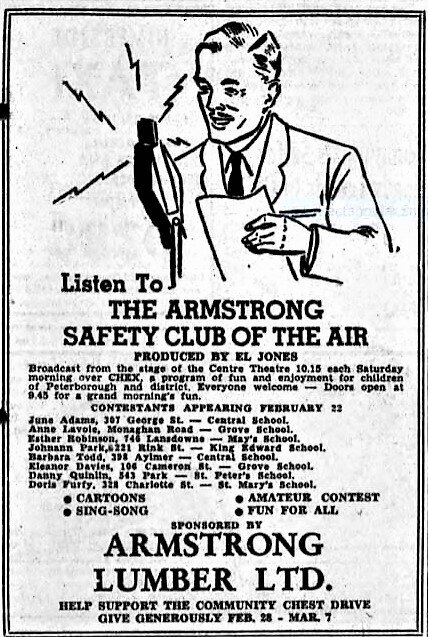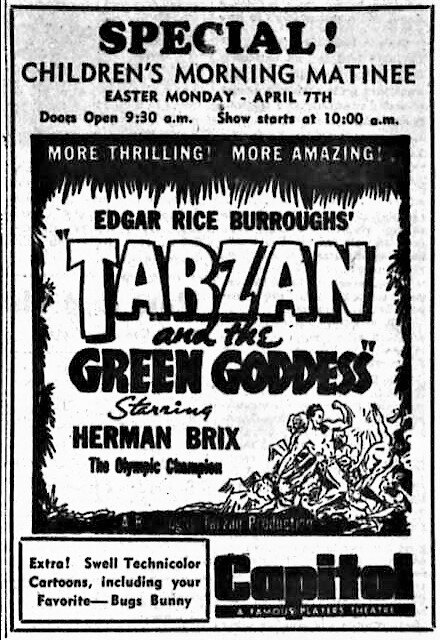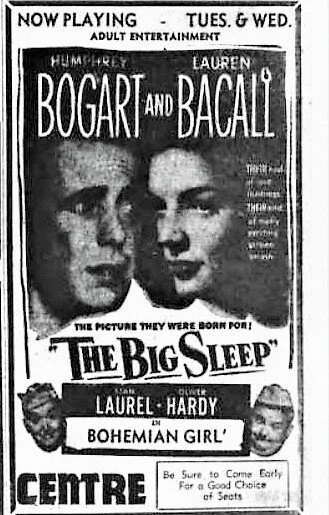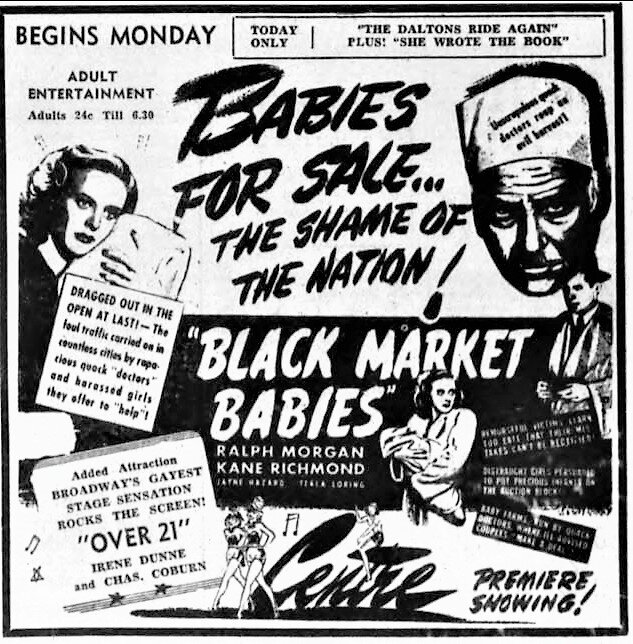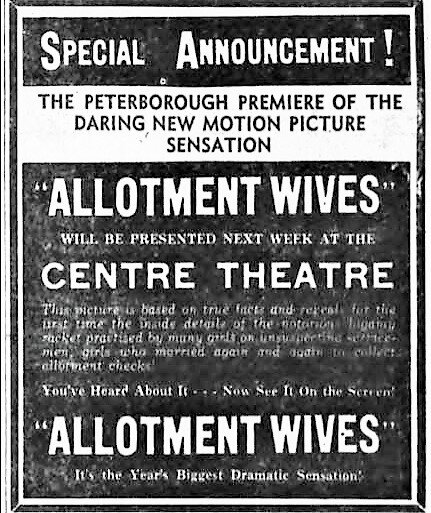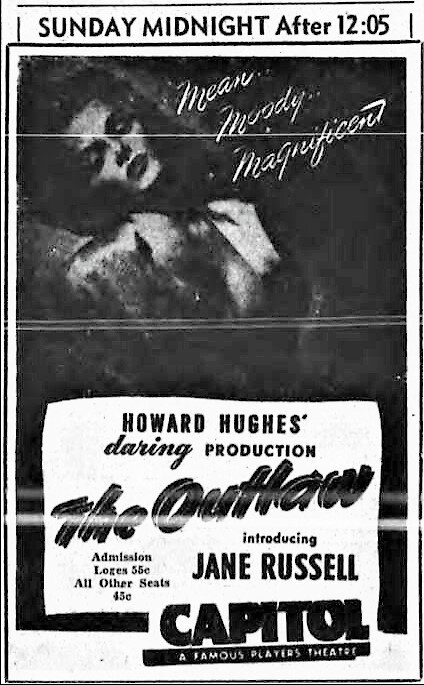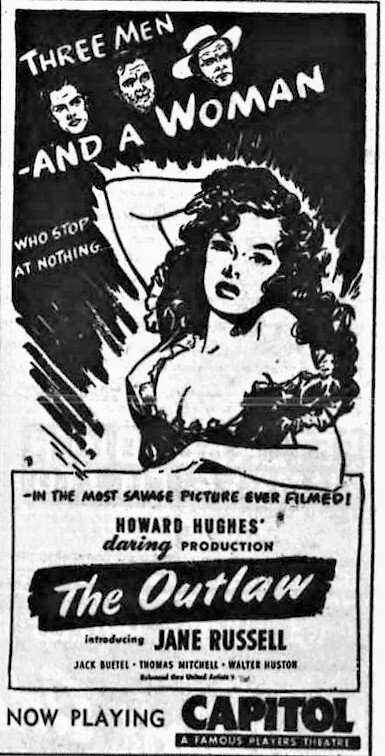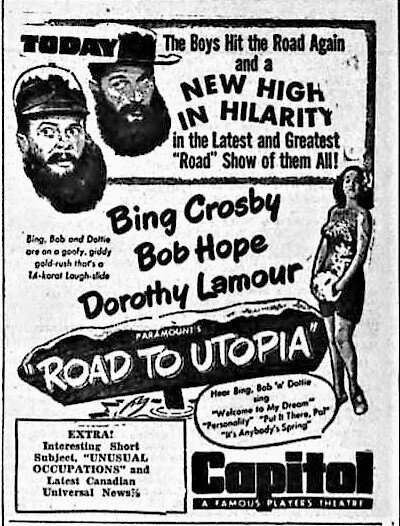The 1940s: War, Prosperity, and a “Miniature Broadway”
A merchandising montage created by the Roy Photographic Studio, sometime around Feb. 15, 1938, when The Buccaneer was screened at the Capitol Theatre. Balsillie Collection of Roy Studio Images, Peterborough Museum and Archives (PMA).
Examiner, Feb. 15, 1938, pp.11 (above), 12 (right). “Thousands of lives at stake . .!”
Making money and forging connections: a special merchandising celebration-promo for the arrival of Cecil B. DeMille’s The Buccaneer. The Roy Studio montage/photo (at top of this page) was seemingly connected to this local advertising campaign — although the ad printed in the Examiner does not match the content of the Roy photo.
Examiner, March 1, 1939, p.9. The Centre opens, and there are three theatres.
*****
While the Capitol certainly had its bright lights, in the late 1930s the Regent was showing its age and the Grand Opera House was a more or less empty, forlorn space. For well over thirteen years, too, the old Royal Theatre site north of Charlotte had “been a dead spot in the heart of the business section.” That was all to change in the coming years.
On March 2, 1939, the Centre Theatre opened — in the space at 346 George Street that had been occupied for years by the Royal Theatre. Sam Ulster, owner of the Embassy Theatre in Toronto and a prominent figure on the board of the Independent Theatres Association of Ontario, had joined forces with Sydney Goldstone, owner of Toronto’s Rex Theatre.
The city was back to three downtown theatres. For a short while the Hanson Theatre Corporation — with ties to Famous Players — had plans to renovate the Grand Opera House and transform it into a large “movie palace.” Plans were drawn up and it even had a name: The Granada; but that didn’t happen (perhaps partly because of the wartime restriction on building), and demolition of the building began Dec. 1, 1941.
Examiner, April 8, 1939, p.7. The three theatres — and much else to do as well, including bowling at the Duffus Recreation Academy on Water Street near the corner of Charlotte. And, below, the minstrel shows (unfortunately) just kept on coming.
Examiner, April 17, 1939, p.7.
Examiner, April 13, 1939, p.9.
Examiner, April 25, 1939, p.9.
Examiner, July 20, 1945, p.9. Movies at Nicholls Oval.
As the thirties passed into the forties, economic conditions improved, and – despite, or perhaps even because of, the coming of the Second World War in September 1939 – the business of movie exhibition would experience its best box-office period ever. The war years were a boom time for movie theatres across North America, in cities and towns, and Peterborough was, as usual, no exception. With the government determining that no new theatres could be opened for the duration of the war, the three local movies houses were kept as busy as ever before — perhaps as busy as the “overcrowding” years of the 1910s when motion pictures were still a relatively new thing.
Everyone, it seems, was going to the movies regularly, once, twice, or maybe even three times a week. Even the Examiner’s new editor, the intellectual opera- and theatre-loving writer Robertson Davies, went to the movies quite often, probably at least once a week (and wrote about many of his experiences).
The attraction — and the distraction — of the mostly Hollywood theatre fare proved irresistible. And movie-watching was not restricted to the theatres. People now saw movies in quantity never before possible, in churches, schools, clubs, and other makeshift venues — even, shades of the early days at Jackson Park, outdoors at Nicholls Oval and Inverlea parks. (And later in the decade, at a drive-in theatre.) The large contingent of soldiers in town (with a training camp in the Exhibition Grounds) were regularly entertained at the pictures — and, on occasion, marched in formation to the show.
The previous decade had ended with a year – 1939 – popularly considered to be “the greatest in the history of Hollywood,” marked by Gone with the Wind, The Wizard of Oz, Stagecoach, Ninotchka, and Mr. Smith Goes to Washington, among others. (One of my personal favourites of that year was Howard Hawks’s Only Angels Have Wings.)
Left: Examiner, Sept. 27, 1939, p.7. Middle: Examiner, May 11, 1939, p.9. Right: Examiner, April 1, 1940, p.9.
In 1939 the Regent picked up yet another continent-wide promo strategy that it would keep in place every Monday evening until the end of its days: Foto-Nite.
Examiner, Aug. 26, 1939, p.9. Announcing the Regent’s first “photo nite.”
Examiner, Oct. 12, 1943, p.7.
Examiner, Aug. 29, 1939, p.9.
Examiner, July 24, 1944, p.7. All you had to do was to register your name, get a photo done of yourself (which could be used for publicity purposes), and be lucky enough to have your name drawn (making sure to show up on the night of the draw). The stunt guaranteed that those registered would turn up again and again on Monday evenings.
Examiner, Dec. 5, 1940, p.11.
Examiner, Dec. 7, 1946, p.7.
Examiner, May 26, 1947, p.7. Towards the end of the Regent’s run.
Examiner, Feb. 26, 1940, p.7. Examiner, Oct. 16, 1940, p.7.
The theatres in wartime mode
The theatres often combined efforts, among other things joining in a massive nation-wide campaign to support the war effort. Locals could go to the theatres and buy war savings stamps, at 25 cents each.
Examiner, July 12, 1940, p.7.
Examiner, July 15, 1940, p.9.
Examiner, Nov. 15, 1940, p.11.
Examiner, Feb. 16, 1942, p.6.
Examiner, Jan. 7, 1944, p.7. About half of the cost of the war was covered by War Savings Certificates and war bonds known as “Victory Bonds.” “Put Victory First” — go to a movie and buy the bonds. Another scheme had the three theatre managers co-operating in an appeal to audience members to bring in “bits of wool” that would be turned over to the Red Cross for use “among the distressed people of England.”
Examiner, Feb. 16, 1942, p.7.
Examiner, April 29, 1944, p.7.
The newly formed National Film Board of Canada (NFB), under John Grierson, began to produce two documentary propaganda series: Canada Carries On and The World in Action.
Examiner, Oct. 16, 1940, p.7.
Examiner, Sept. 16, 1942, p.7. This time, the NFB’s Women Are Warriors from the Canada Carries On series; plus colour cartoon and Capitol News with the most amazing Tarzan yet.
The National Film Board used the U.S. newsreel March of Time as a model for its monthly wartime series Canada Carries On. It played in theatres across North America and abroad, as did its other newsreel series, World in Action. Also, the Regent goes for a “continuous” program — you could come into the theatre any time you wanted and see the whole program right through, leaving when you could say, “This is where we came in.” The Centre had introduced this policy when it opened in 1939; it proved successful, and the Regent and Capitol followed suit.
The continuous programs had plenty on offer:
Left (two columns): March 3, 1941, p.7. Right: Examiner, Dec. 8, 1941, p.7. Continuity: over thirty years earlier (1908) Peterborough had seen the real Lillian Russell on stage at the Grand Opera House.
Left: Examiner, May 17, 1941, p.7. Right: Examiner, June 5, 1941, p.4.
Examiner, Jan. 18, 1941, p.7. The Regent’s standard program: often a “B” movie, as here, or a second-run feature, plus a comedy short and a newsreel.
Examiner, March 31, 1941, p. A double feature at the Centre, with a newsreel.
Examiner, Aug. 18, 1942, p.7. Winner of the Academy Award for Best Picture, 1942 (beating out Citizen Kane). The Capitol, the main theatre for “first run” pictures, often had just one big feature, news, and a short — in this case a symphony orchestra rendition of Aida.
The movie theatres did not yet have concession stands. But you could get snacks nearby
Examiner, Feb. 8, 1941, p.11.
“I remember always going into the Nuttery before we went to the movies,” a friend told me. “Peanuts & raisins ... still warm!!! At that time you could bring food into the theaters!”
Examiner, April 5, 1941, p
Examiner, Jan. 16, 1946, p.14.
Examiner, Jan. 20, 1942, p.7.
Examiner, May 19, 1942, p.7.
Examiner, July 7, 1942, p.7. The Capitol with the big new pictures, the Centre with a re-run (Meet Joe Doe, released in 1941) — but an interesting short, The Birth of the Movies, which I haven’t been able to track down.
Stage acts — sometimes still part of the motion picture show
Left: Examiner, Feb. 24, 1940, p. Right (two columns): Examiner, April 12, 1941, p.2.
Left: Examiner, July 3, 1939, p.9. Middle: Examiner, June 4, 1946, p.7. Right: Examiner, Aug. 23, 1947, p.7. In 1939 John Murray (“Curley”) Gibson, a local singer/entertainer, was doing a “one night a week” stage show at the Centre when he was offered a permanent job as doorman and later moved up to chief usher and assistant manager.
Left: Examiner, May 25, 1940, p.7. Right: Examiner, Aug. 23, 1946, p.7. In 1946 the Club Aragon opened on Lansdowne St., east of the city, offering competition with its own top-notch music over the following decades.
Left: Examiner, Dec. 27, 1943, p.7. Middle: Examiner, Dec. 28,1943, p.7. Right: Examiner, July 10, 1943, p.7. About Fantasia, Robertson Davies wrote, “I felt as though I had been struck over the head for two hours and a half, not with a club, but with a pillow.”
Left: Examiner, Jan. 19, 1944, p.7. Right: Examiner, Feb. 3, 1944, p.7. When I was young, it wasn’t who do you like, The Beatles or the Rolling Stones? — it was Roy Rogers or Gene Autry?
Below, a glimpse of a future trend — smack dab in the depths of a male-centred world. But first they had to create victory. What were they drinking?
Examiner, March 11, 1944, p.8.
Examiner, Dec. 30, 1944, p.7.
Examiner, June 30, 1945, p.7.
Examiner, Aug. 3, 1946, p.7. The theatres dodged holiday and Sunday closing laws by opening just after midnight, but not without controversy. There were complaints that they kept youngsters out until “a late hour in the morning” and ruined them for work and school the next day. But, with a stop now and then, the shows went on.
Sometimes on Sunday
For Whom the Bell Tolls — the theatres also did sometimes stay open on Sundays, but not to show pictures. The Regent especially had regular services over quite a long period.
Examiner, Oct. 30, 1943, p.9.
Examiner, Oct. 13,1945, p.9.
Examiner, Jan. 19, 1946, p.3.
Examiner, Feb. 23, 1946, p.9.
A star-laden late-war effort from Hollywood . . . amidst the latest news
Left: Examiner, March 28, 1945, p.7. Hollywood stars helping out the war cause, presumably. Right: Examiner, April 26, 1945, p.7.
. . . and then, soon after that, not a movie ad, but my favourite headline of the decade
Examiner, May 7, 1945, p.1. The editor by that time was the novelist Robertson Davies. The typo was corrected in the Evening Edition.
Boxoffice, May 19, 1945, p.100.
Harry Yudin takes over at the Centre Theatre
In July 1945 a major ownership shift occurred at the Centre Theatre. The Trio Theatre company sold the Centre to a recently formed company, Peterborough Centre Theatre Ltd. It was a family group led by a well-established Toronto theatre owner, Hyman Freedman, and his son Sam and son-in-law Harry Yudin. Harry Yudin moved to Peterborough from Toronto and became the manager. Yudin became actively involved in local business and sports organizations and was an integral part of the Jewish community. The Centre’s ads got noticeably bigger.
Examiner, Oct. 13, 1945, p. 7.
Examiner, Dec. 8, 1945, p.7.
Postwar Theatres — Dances — Radio — Lawn Bowling and Baseball
Examiner, Oct. 6, 1945, p.7. Postwar: not just lawn bowling and Canada Starch Presents — but Tony Pastor and His Orchestra, Monster Bingo, and the Roseneath Fair.
Examiner, Dec. 5, 1945, p.7. For its second great hit, the Regent has a serial.
Examiner, Jan. 23, 1945, p.5. The Capitol’s owner has an anniversary.
Examiner, Dec. 12, 1945, p.7. An Examiner headline in October that year said: “British Films Are Enjoying the Biggest Boom in Their History.” Editor Robertson Davies went to the British movie Colonel Blimp and commented that the picture was “not particularly well attended.” That was too bad, he said, because it could have led people who complain about films being a bad influence on the young to “reconsider their opinions.”
In the 1940s, it seems everyone went to the motion picture show
— including Donald Duck, who began to rival Mickey Mouse in the Disney stable of stars.
Examiner, Jan. 18, 1944, p.11.
Examiner, Aug. 21, 1945, p.11. Dagwood went too, perhaps a little too much.
Well, maybe not everyone wanted to go . . . perhaps it depended on your diet.
Examiner, Sept. 10, 1945, p.10.
Left: Examiner, Sept. 7, 1945, p.11. Right: Examiner, Nov. 16, 1946, p.7. Styles: what to wear to the movies — and maybe even (at the Summer Gardens) experience the movie-making atmosphere.
As always — but even more so — moving pictures could be seen not just at the theatres, but all over the place
Examiner, March 20, 1947, p.18.
Peterborough Review, June 15, 1939.
Examiner, Feb. 11, 1947, p.
Examiner, March 16, p.9.
Examiner, March 29, 1947, p.8. It wasn’t just evening movies at Peterborough Collegiate Institute (P.C.I.). Movies were regularly screened for and by students during the day.
Examiner, Feb. 9, 1946, p.9.
Examiner, Dec. 3, 1945, p.9.
Examiner, April 20, 1946, p.3.
Examiner, Nov. 27, 1944, p.9.
Examiner, Jan. 27, 1947, p.9.
Examiner, April 10, 1946, p.9.
Examiner, April 28, 1947, p.7.
Examiner, Nov. 20, 1947, p.15.
Examiner, Feb. 12, 1946, p.11.
Examiner, Dec. 8, 1941, p.9.
Examiner, Nov, 28, 1946, p.9.
Examiner, Sept. 2, 1943, p.16. At the “Spring to Fall” event in the Wartime Housing Staff House, Gordon K. Fraser, M.P., presented horticultural awards and a variety of National Film Board films were screened.
The children’s domain of Saturday morning continued . . .
Left: Examiner, April 12, 1946, p.7. Right: Examiner, May 10, 1946, p.7.
Left: Examiner, Dec. 27, 1946, p.7. Middle: Examiner, Feb. 21, 1947. Right: Examiner, April 5, 1947, p.7.
Introducing a new genre: what later came to be known (thanks to French critics) as film noir — dark, cynical, pessimistic, with conflicted male anti-heroes and, just maybe, a deceitful woman or two
Examiner, Sept. 22, 1945, p.7.
Examiner, Sept. 29, 1945, p.7.
Examiner, Dec. 9, 1944, p.7.
Examiner, Oct. 10, p.7. Minor film noir.
Examiner, Oct. 21, 1946, p.7.
Examiner, Dec, 28, 1946, p.7.
Examiner, Feb. 17, 1947, p.7.
Examiner, Sept. 8, 1947, p.7.
Right: After To Have and Have Not, it was “Bogart and Bacall.” But Lauren’s name is in very small type here. On the very same day I arrived in the world, April 9, 1944, a married Humphrey Bogart was romancing his co-star. To Have and Have Not was in production on the Warner Brothers lot, with location shooting on Balboa Island and Laguna Beach, California, from February 29 to May 10, 1944. Just while I was taking my first breaths of fresh Ontario hospital air, Bogie and Bacall were falling in love on a movie set in sunny California.
Examiner, Nov. 10, 1947, p.7. Once was not enough — the Centre often did second runs of films that had proved popular at the Capitol.
Examiner, Sept. 22, 1945, p.7.
Romance and comedy and hubba hubba
Examiner, Aug. 15, 1946, p.7. State Fair, like other popular movies, had repeated screenings. I saw it at an early age, but it would have been later than this, in a re-run. Now I can recognize its highly romanticized and idealized sense of an easy rural life, but at the time that did not bother me in the least.
Examiner, Oct. 5, 1945, p.7.
Examiner, Oct. 23, 1946, p.7. The term “hubba hubba” to describe beautiful women was popular in my youth, but it has now quite happily faded from common usage. It also seems that the “Hubba-Hubba Song” did not catch on.
From the delights of the mid-west U.S. State Fair, a direct trip back to Paris and Notre Dame (another of those vintage 1939 films)
Examiner, Aug. 17, 1946, p.7. As the Examiner reported, Aug. 21: “Two citizens emerged from a local theatre Tuesday night just as the Hunchback of Notre Dame was clanging out a warning on the Parisian cathedral bells. When they stepped onto the street, the bells were still ringing. Only they were not those of the hunchback. The Market Hall timepiece was striking ten o’clock.”
The unusual and sensational: always a place in motion picture exhibition
Left: Examiner, Sept. 25, 1946, p.7. Right: Examiner, May 31, 1946, p.7. Allotment Wives: “The Year’s Biggest Dramatic Sensation” — well, maybe not.
Left: Examiner, July 26, 1947, p.7. Middle: Examiner, Aug. 2, 1947, p.7. Right: Examiner, Aug. 6, 1947, p.7 — in case you hadn’t caught it at the midnight show. The Outlaw, one critic said, “wasn’t much.” But it ran into censorship problems: produced by 1941, released in 1943, withheld from distribution until March 1946 — and then becoming one of the decade’s biggest box-office hits, reflecting something of a shift in movie-going culture.
The return of Deanna Durbin and a montage of ads from the mid-1940s . . . including the non-filmic Count Basie
Left: Examiner, June 4, 1945, p.7. Right: Examiner, Aug. 9, 1945, p.7.
Left: Examiner, July 6, 1946, p.7. Right: Examiner, July 17, 1946, p.7.
Examiner, Nov. 23, 1946, p.7.
Examiner, May 6, 1946, p.7.
Examiner, April 5, 1947, p.7. The prices go up at the Centre and Regent.
Examiner, April 5, 1947, p.7.
Examiner, July 8, 1947, p.7.
Examiner, Oct. 4, 1947, p.7.
Examiner, July 9, 1947, p.7.
Examiner, Oct. 22, 1947, p.7. Not just Peterborough — but Norwood-Havelock too.
Examiner, Nov. 24, 1947, p.7.
Examiner, Oct. 14, 1947, p.10. One of the many contests that tied the Examiner and its readers into the flow of pictures at the theatres. Five top prizes — and then ten Capitol theatre tickets.
“B”-movie Westerns — in the 1950s, basic programming fodder for television
Examiner, Nov. 22, 1945, p.7.
Examiner, Nov. 19, 1947, p.7.
Early Westerns played into kids’ imaginations. I remember seeing Bells of Rosarita one Saturday afternoon with a bunch of my neighbourhood friends on Victory Crescent — and we came home and played on our front yards as though we were in the movie.
Nominated for Best Picture of 1946 — but a long time coming to Peterborough
Examiner, March 14, 1947, p.7. Unusually, not just an ad, but a convenient mail order form.
Examiner, March 15, 1947, p.7.
In spring 1947 Centre manager Harry Yudin made Examiner editor Robertson Davies quite happy. He brought Laurence Olivier’s much praised Henry V to Peterborough. The long-awaited Henry V had been produced in the U.K. in 1944 and released in the United States in 1946. Davies had complained on the editorial pages that cities like Peterborough were being unjustly deprived of the “great movies” and that only the large cities were getting to see them. “There appears to be an idea that [Henry V] would not draw audiences in smaller centres,” Davies said. “Hollywood provides, and will continue to provide, the bulk of the world’s film fare, and although Hollywood films have many obvious faults, there are exceptions which should not be discounted.”
Over the following years Harry Yudin would continue to keep up with the Centre’s second-run double features, but he would also bring more and more unusual films — and especially the opera on screen — to the Centre.

